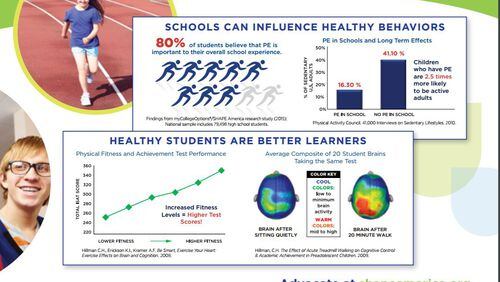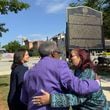Only eight states in the country require recess for students during the school day, prompting SHAPE America to team up with the Centers for Disease Control and Prevention to advocate for recess for students in all grades, deeming it a "critical" part of the school day.
Georgia mandates physical education in grades K-8, but does not require daily recess.
Here is an essay by SHAPE America CEO E. Paul Roetert.
By E. Paul Roetert
Active recess has taken a giant leap forward, having been validated by two of the nation’s leading school health authorities as a critical part of the school day. And what’s more, guidance is now available to help schools make the most of it.
Thanks to a joint effort of the Centers for Disease Control and Prevention and SHAPE America - Society of Health and Physical Educators, schools now have resources to help them create active recess periods that use classroom breaks to full advantage. Our hope is that these resources will help more schools realize the value of recess.
Daily recess has been shown to have a profound impact on a child’s social, emotional, physical, and cognitive development. Properly structured and monitored by well-trained staff or volunteers, recess helps students achieve the recommended 60 minutes of daily physical activity, improving their overall health and well-being, academic achievement, and self-esteem.
Recess is not a substitute for an effective physical education program, which teaches students the skills and knowledge they need to establish and sustain an active lifestyle. Physical education teachers assess student knowledge, motor skills and social skills, providing necessary instruction on a variety of physical activity experiences in a safe, supportive environment. The goal is to help students achieve physical literacy – the ability to move with competence and confidence in a wide variety of physical activities in multiple environments that benefit the healthy development of the whole person.
When recess is incorporated in partnership with physical education, students have the opportunity to apply and practice their knowledge and skills outside the classroom. Through games and play, they learn conflict resolution and how to work fairly with others. Recess allows them to expand their imaginations and creativity, and blow off steam in an environment where the mind-body connection can flourish.
A prime example of this can be seen at Thomasville Primary School in Thomasville, NC. Incorporating an active recess program has had a profound effect on the school’s K-3 students, who had exhibited a range of problems, from obesity to unruly behavior to playground bullying. Recess had been compromised by a small, unwelcoming playground, and was occasionally withheld as punishment. The district’s visionary Healthy Eating Active Living Coordinator, Alyson Shoaf, embarked on radical recess reform after attending a recess training session at the SHAPE America National Convention in Minneapolis last year.
With support from principal Angela Moore, the playground was rehabilitated with individually colored and uniquely equipped activity zones and structured activities and games were incorporated into each day’s 30-minute recess, with teachers actively involved in their classes’ recess time. As a result of these efforts, student behavior and attitudes have improved so dramatically that the district has instituted a games-based active recess in its middle and high schools.
In Fort Worth, Texas, a pilot program for kindergarten and first-grade students instituted four 15-minute recess breaks each day (two before lunch and two after), along with a character-building curriculum called “Positive Action,” designed to curb bullying and help improve self-esteem. The program has proved so successful that it has expanded to private and public schools statewide and several schools in Ohio and Kansas. Parents say that their children’s after-school activities have changed as a result of the program – - instead of coming home exhausted and watching TV or playing video games, kids are motivated to complete their homework in 30 minutes, so they can go outside to ride bikes and play with other kids.
Now students throughout the U.S. can realize similar benefits by using the new guidance documents created by SHAPE America and CDC. Strategies for Recess in Schools and Recess Planning in Schools: A Guide to Putting Strategies for Recess into Practice give schools a blueprint for implementing successful recess programs such as those in Thomasville and Fort Worth.
The evidence-based strategies are designed for students from grades K through 12. Although middle and high schools may not call it “recess,” the goal is still the same – - to offer students a period of time to be active outside of classroom physical activity and physical education. It is just one component of SHAPE America’s 50 Million Strong commitment, which seeks to empower all children to lead healthy and active lives through effective health and physical education programs.
As Holly Hunt, chief of the CDC's School Health Branch, notes, "Schools can create recess environments that support physical activity, positively impact student learning, and improve classroom behavior, and these should provide all students with the opportunity to choose the physical activities in which they’d like to engage in. “
Just last month, we marked the first anniversary of the signing of our country’s new education plan, the Every Student Succeeds Act, which replaces the controversial No Child Left Behind Act of 2002.
When ESSA kicks into gear in schools at the beginning of the 2017-2018 academic year, school health and physical education, for the first time, will be considered an integral part of a student’s well-rounded education, along with subjects such as art, music, civics, and science. The implementation of ESSA will give a new generation of students a chance to reap the benefits of leading healthy, active lives.







